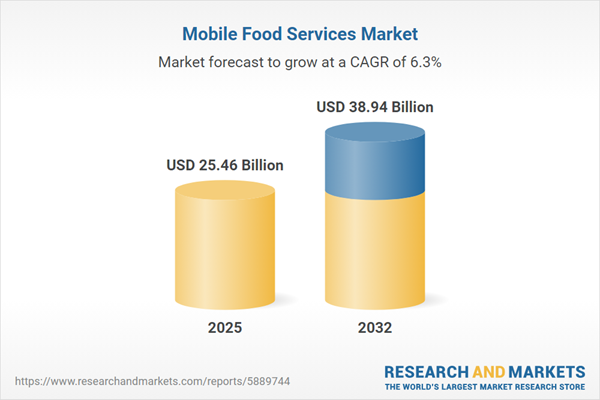Speak directly to the analyst to clarify any post sales queries you may have.
Senior leaders in the mobile food services market face a rapidly evolving landscape, shaped by changing consumer preferences, dynamic regulatory pressures, and the accelerated adoption of digital technologies. Staying ahead requires clear strategy, robust sector intelligence, and a focused approach to sustainable growth.
Market Snapshot: Mobile Food Services Market Dynamics
The global mobile food services market is on a persistent upward trajectory, fueled by urban expansion and continual integration of digital tools within operations. Providers are evolving their service models to better address the demand for convenience, swift service, and streamlined experiences. Automated ordering systems and contactless payment methods are now integral to operations. As economic cycles shift and regulations become more complex, competition is intensifying. Operators are increasingly focused on localized strategies, adapting their offerings to regional tastes and prioritizing compliance to reinforce their market positions within this dynamic sector.
Scope & Segmentation of the Mobile Food Services Market
- Service Models: Food trucks, street vendors, catering formats, and concession stands provide diverse access points for businesses and consumers in varied environments.
- Food Types: Menu options include hot and cold beverages, gourmet desserts such as ice cream and frozen yogurt, a range of international cuisines, and ready-to-eat meals, adapting to local and evolving tastes.
- Distribution Channels: Operators leverage on-site sales, event-based services, online ordering, and partnerships with third-party delivery platforms to maximize reach and efficiently allocate resources.
- End Users: The market serves corporate events, entertainment venues, sports complexes, and metropolitan areas, with each segment requiring customized offerings and tailored operational models.
- Price Tiers: Ranging from value-driven menus to premium price points, pricing strategies are structured to serve a broad demographic and support inclusivity.
- Regional Coverage: Variability in technology adoption, regulatory landscapes, and consumer behavior is seen across the Americas, Europe, Middle East & Africa, and Asia-Pacific, requiring savvy adaptation for local effectiveness.
- Company Analysis: Industry leaders—such as Aramark Uniform Services, Compass Group USA, Sodexo, Delaware North Companies, HMSHost International, SSP America, Centerplate, Levy Restaurants, Spectra Food Services & Hospitality, and On Location Experiences—drive advancement through continual service enhancement and integration of new technologies.
- Technology Focus: Strategic investments in digital payment platforms, menu analytics, and kitchen automation enable operators to respond rapidly, improve transparency, and increase operational efficiency in response to shifting demand.
Key Takeaways for Senior Decision-Makers
- Building digital infrastructure with omnichannel capabilities supports close monitoring of shifting demand patterns, streamlines multi-region management, and strengthens customer engagement.
- Utilizing menu analytics and process optimization techniques helps create targeted, segment-specific strategies, increasing differentiation both in urban environments and at event-based venues.
- Committing to ethical sourcing and recyclable packaging enhances compliance, aligns business practices with rising stakeholder expectations, and helps build lasting brand credibility.
- Adopting asset-light business models, including franchise systems and consolidated supply chains, facilitates expansion while mitigating financial and operational risk in new markets.
- Working proactively with supply chain partners improves agility, reducing the likelihood of disruptions and moderating the effects of market uncertainty.
- Launching themed menus and experimenting with innovative service formats ensures ongoing relevance and adaptability amid evolving market pressures.
Tariff Impact: Navigating Cost and Supply Chain Pressures
Recent changes to United States tariffs have raised costs for essential kitchen equipment and critical supply inputs. Operators are responding by expanding supplier bases, strengthening cold-chain logistics, and establishing long-term vendor agreements. Local sourcing initiatives and greater automation in kitchen processes are improving resilience. These efforts help limit the disruptive impact of trade shifts and allow organizations to maintain service standards as industry challenges develop.
Methodology & Data Sources
This assessment of the mobile food services market is based on comprehensive executive interviews, rigorous comparative benchmarking, and thorough regulatory review. Scenario analysis and granular segmentation contribute targeted, actionable insights crafted for sector leaders.
Why This Report Matters for Senior Decision-Makers
- Supports the structured implementation of digital solutions while navigating regulatory requirements, helping leadership align strategy with sector progression and change.
- Clarifies pathways for technology-driven innovation and collaborative partnerships to reinforce operational resilience and capture growth in diverse regions.
- Connects technology investments directly to organizational goals, enabling organizations to respond quickly and effectively to evolving market dynamics and competitive shifts.
Conclusion
Effective strategic decision-making empowers leaders to preempt risk, identify growth opportunities, and maintain competitive strength as the mobile food services market evolves.
Additional Product Information:
- Purchase of this report includes 1 year online access with quarterly updates.
- This report can be updated on request. Please contact our Customer Experience team using the Ask a Question widget on our website.
Table of Contents
3. Executive Summary
4. Market Overview
7. Cumulative Impact of Artificial Intelligence 2025
Companies Mentioned
The companies profiled in this Mobile Food Services market report include:- Aramark Uniform Services, Inc.
- Compass Group USA, Inc.
- Sodexo, Inc.
- Delaware North Companies, Inc.
- HMSHost International, Inc.
- SSP America, Inc.
- Centerplate, Inc.
- Levy Restaurants, LLC
- Spectra Food Services & Hospitality, LLC
- On Location Experiences, LLC
Table Information
| Report Attribute | Details |
|---|---|
| No. of Pages | 180 |
| Published | November 2025 |
| Forecast Period | 2025 - 2032 |
| Estimated Market Value ( USD | $ 25.46 Billion |
| Forecasted Market Value ( USD | $ 38.94 Billion |
| Compound Annual Growth Rate | 6.2% |
| Regions Covered | Global |
| No. of Companies Mentioned | 11 |









